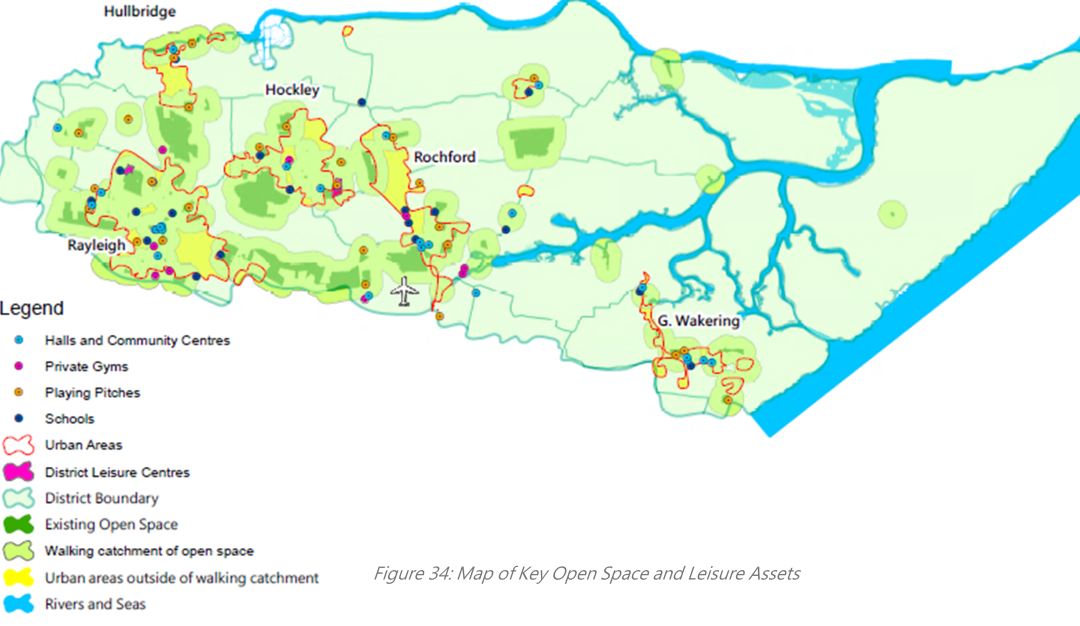New Local Plan: Spatial Options Document 2021
 Open Spaces and Recreation
Open Spaces and Recreation
Relevant Plan Objectives: 9, 15
Access to a network of high-quality open spaces and facilities for sport and physical activity is important for the health and well-being of communities. National policy requires plans to be based on robust and up-to-date assessments of the need for open space, sport and recreation facilities (including quantitative or qualitative deficits or surpluses) and opportunities for new provision.
Open and green spaces can take many forms, from formal sports pitches to open areas within a development, linear corridors and country parks. The District is currently home to around over 140 identified open spaces that exist in a mixture of public and private ownership. A diverse range of formal and informal recreation takes place on local playing pitches and in built facilities (such as leisure centres).

Through the preparation of the plan, it is possible to safeguard locally-important green spaces from urbanisation through the 'local green space' designation. In order to qualify as local green space, an area needs to be:
- in reasonably close proximity to the community it serves;
- demonstrably special to a local community and holds a particular local significance, for example because of its beauty, historic significance, recreational value (including as a playing field), tranquility or richness of its wildlife; and
- local in character and is not an extensive tract of land.
Spaces proposed for local green space status are identified in the settlement profiles later in this Paper.
In addition to local green spaces, there may also be other areas of land that do not hold unique local significance but nevertheless make a strong positive contribution to local well-being worthy of protection and enhancement, such as country parks and woodlands.
Feedback from the Issues & Options consultation was clear about the importance of residents having access to well-maintained and accessible open and green spaces. Feedback also highlighted the need for a qualitative and quantitative audit of both open spaces and recreational facilities to consider ways to enhance quality and access. Building from this feedback, the Council has since sought to undertake a number of studies to identify the current and future issues and opportunities relating to our open spaces and recreational facilities.
The emerging Open Space study for the District has assessed the quality and accessibility of existing open spaces, including whether these open spaces may qualify as local green spaces. Through this evidence base it has been possible to identify areas of in the District that do not have suitable walking access to any areas of open space, including parts of central and eastern Rayleigh, northern Rochford, central Hullbridge and many of the outlying villages and hamlets. These communities are those that may benefit most directly from the provision of new spaces.
Playing Pitch and Built Facilities Studies have been prepared to assess the quality and adequacy of facilities for formal and informal sports and recreation. These studies suggest that facilities across the District are generally of good quality but that some local facilities could benefit from enhancement. Existing and projected overplay of pitches is a particular issue affecting the growth of local sports clubs. Assuming around 7,200 homes are built by 2040, Sport England's Playing Pitch Calculator identifies an additional peak weekly demand for up to 18 match sessions for football at all levels, 1.8 match sessions for rugby union, 1.6 match sessions for hockey and 55 match sessions per season for cricket. However it is important to recognise that some of this additional demand can be met from improved utilisation of existing under-used pitches, whilst an overarching recommendation from these studies is to explore the potential for up to six new 3G pitches, which are generally able to sustain higher levels of use than grass pitches. A 3G Pitch Feasibility Study has now been prepared exploring opportunities at:
- Burroughs Park (Great Wakering)
- Clements Hall Leisure Centre
- Greensward Academy
- Hullbridge FC
- King Edmund School
- Rayleigh Leisure Centre
The Studies both advocate a hierarchy approach to planning for recreational facilities, tiering facilities as hub-sites and key centres with all other facilities being of local importance. Such an approach could be embedded into the plan in order to prioritise and direct investment and renewal to those facilities of greatest importance.
|
Category |
For playing pitches |
For indoor recreation |
|
Potential 'Hub Sites' |
King Edmund School |
Clements Hall Leisure Centre Rayleigh Leisure Centre King Edmund School |
|
Potential Key Centres |
Greensward Academy Sweyne Park School Westcliff Rugby Club Burroughs Park Rawreth Lane Playing Fields Rayleigh Sports and Social Club |
Greensward Academy Sweyne Park School Fitzwimarc School |
OPTIONS - Non-exclusive options to meet our existing and future open space and recreation needs through the plan include:
- Designating and protecting locally-important spaces through the local green space designation where they meet the criteria for inclusion
- Designating and protecting other important open spaces through the plan which are not eligible for local green space designation but are still worthy of protection and enhancement
- Embedding a hierarchy approach into policy that seeks to prioritise and direct investment to the most important recreational facilities, including potential hub sites and key centres
- Ensuring our qualitative and quantitative open space and recreational needs are met within our area through the plan, and any supporting infrastructure delivery plan, by:
- Requiring new developments to make suitable on-site provision for new open and green spaces, and/or sport and recreation facilities, or
- Requiring new developments to contribute to improving the quality and accessibility of existing open spaces and recreation facilities in the locality, or contributing to enhancing open space or recreation facilities at existing hub sites and key centres
- Working with neighbouring authorities to explore opportunities to address our open space and recreational needs across boundaries (such as hub sites in other authority areas)
